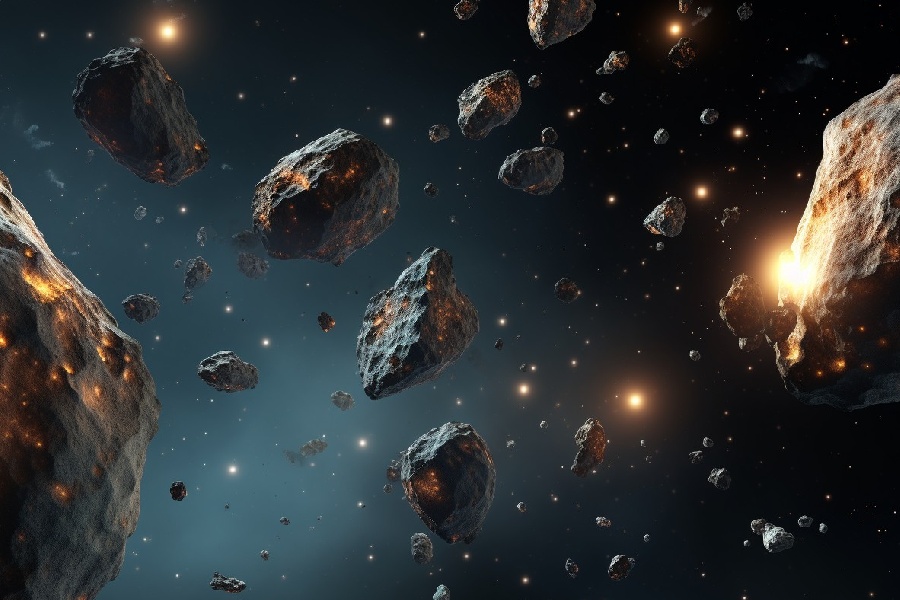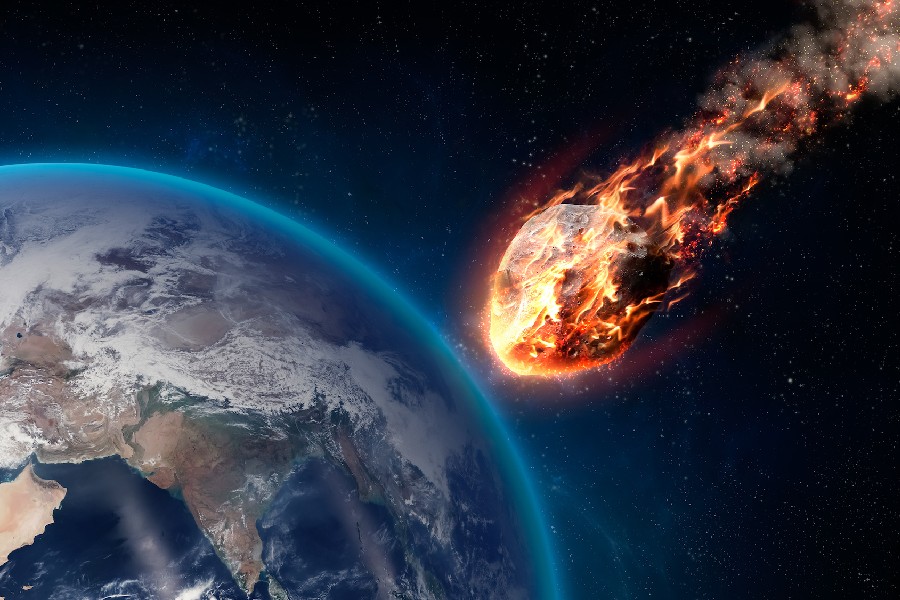This survey illuminates current scientific understandings of meteoroids by tracing discoveries revealing their intriguing extraterrestrial origins. We will delve into key meteoroid facts, including their composition and speed, in addition to their distribution and other characteristics.
Also spotlighted are the contrasting smaller meteoroid sources constantly bombarding Earth’s atmosphere. Grab a hot chocolate and cozy up, re-envisioning “shooting stars” as diverse mineral emissaries arriving from asteroids, comets, and beyond through insightful perspective into just what are meteoroids.
What Are Meteoroids?
So, what’s the definition of meteoroids? Meteoroids are small celestial objects ranging from a grain of sand to a few meters. Originating from comets or asteroids, they create meteors when entering Earth’s atmosphere.
Surviving meteoroids on Earth’s surface become meteorites. Meteoroids contribute to meteor showers, creating bright streaks in the night sky.

Meteoroid Facts
Meteoroids travel through space between planets
Distribution and population
Meteoroids populate interplanetary space, concentrated along orbital planes of originating bodies like comets or asteroids. Density varies across the solar system and meteoroid shear zones.
Models indicate that over a trillion objects exist, ranging from kilometers to microscopic fragments. The flux differs when Jupiter family comet trails intersect with Earth.
Transiting through space
Rocky debris and icy grains shed at low velocities, persisting unmelted for eons unless colliding on routes, perhaps delivering water/organics supporting life’s emergence on planets.
Meteoroids may cycle between accretions and then shedding along orbital paths, circling stars, providing insights into our solar system’s early history and composition.
Meteoroids are often fragments of asteroids
Originating bodies
Some meteoroids represent asteroid collision shards or debris released by Mars/Jupiter gravitational tugs. Differentiated fissions indicate varied mineral parent bodies.
Nickel-iron chunks hint at fragments originating from planetesimal cores. Carbonaceous chondrite meteoroids offer primitive, volatile-laden peeks into early solar system chemistry.
Insight proxies
Analyzing the composition of meteoroids through parameters like isotope decay rates and crystal structures provides insights into planet formation.
This acts as a tracer, linking meteoroids back to their asteroid parent bodies and showing our solar system evolved over complex stages that are still being decoded. More fragile outer layers are unlikely to survive atmospheric entry except fragmented in streams.
Some meteoroids are made of rock
Stony meteoroids and subsequent meteorites categorized by dominant silicate minerals like olivine or pyroxene mixes exhibit layered structures, indicating igneous processing on parent asteroids molten early on when radioactive materials drove internal heating prior to geological cooling.
Origins traced through craters
High iron indicates origins nearer protoplanet cores. Impactor remnants and debris scattered from huge craters still visible on Vesta/Ceres aid in tracing specific meteoritic fragments to these differentiated asteroids, showing the geologic consequences of titanic collisions.
Meteorites that contain iron or a mix of iron and nickel
Core fragments
Some meteoroids contain iron/nickel mixes, indicating origins from exposed planetary core mantles during collisions between protoplanets, coalescing planetesimals or smashed differentiated asteroids. The dense metal-rich phenomenon represents only a fraction of space rock falls.
The highest proportions of elements like nickel and iron come from the innermost regions of shattered parent bodies. These traces provide a rare glimpse into the deep layers that formed early in the swirling solar accretion disk.
Identifying source bodies
Studying isotope ratios like tungsten-182 traces some fragments potentially arriving from Mercury while others resemble melted asteroids. But only remnants survive melting, mixing clues to disentangle exact origins. Iron meteorites exhibit crystallization patterns from ancient cooling also diagnostic of parent bodies.
Meteoroids move at high speeds
Speeds in space
Meteoroids reach Earth at varying speeds, which depend on where they come from and how gravity affects them as they plunge into our sun’s strong gravitational pull Faster comets shed grains at speeds exceeding escape velocity, unable to reach the planet’s surface intact.

Deceleration through atmosphere
As meteors dive deeper into Earth’s atmosphere, the resistance they encounter generates heat, causing the outer grains to melt and create the streaks we see as meteors. Although their speed decreases rapidly during descent, they still hit the surface at velocities comparable to bullets. These tiny cosmic grains can accumulate on Earth’s surface as extraterrestrial dust, unnoticed for millions of years.
Meteoroids encounter resistance as they enter Earth’s atmosphere
Atmospheric effects
High-speed meteoroids slam into Earth’s atmosphere, compressing the gas layers. This creates glowing bow shock cones around the meteoroids as temporary craft dragging wakes. The kinetic energy converts into extreme heat from friction, also slowing the object’s velocity. Ionized paths left in the atmosphere trace the meteoroid’s trajectory.
Breakup and vaporization
Most member grains of debris stream fully combust high above the surface, contributing ions and dust to mesosphere layers. Some larger fragments survive partly, crashing as invaluable meteorites holding pre-terrestrial chemistry information.
When meteoroids collide with populated areas, the amount of damage they cause can vary greatly, ranging from minor to catastrophic. The size and density of the meteoroid play a significant role in determining the energy released during impact.
The fastest meteoroids originate from stellar outgassing
Originating sources
The fastest meteoroids that make their way to Earth actually come from when stars release gas super quickly or get a gravitational boost near Jupiter. These meteoroids can reach over 40 miles per second when they hit our atmosphere, creating intense sonic booms.
On the other hand, particles from comets that break off can go even faster than chunks from asteroids.
Speed records
When comets come really close, they shoot out fountains of dust grains that form long trails. These particles can overtake planets in their speedy journey.
When collisions happen on the front side of comets, they can even push particles toward the Sun, gaining great velocities. Some of these particles are so fast that they manage to escape the gravity of our solar system and end up in their own orbit around the Sun.
Meteoroids vary in origin, size, composition, and shape
Diverse traits
Meteoroids exhibit wide-ranging traits depending on formation mechanics from parent bodies plus subsequent transit alteration factors like irradiation, collisions, and heating cycles. Icy cometary grains, rocky asteroid chunks, and dense metallic crystals each bear properties revealing origins.
Informing models
Studying characteristics like porosity, mineralogy, and oxidation levels leads to composition clues shed by progenitors. These clues trace back to early solar system conditions in the protoplanetary disk. By looking at these clues, scientists can get insights into the conditions that were present, like the temperature and chemical differences.
These objects then got modified across eons through processes leaving identifiable markers. These markers help untangle our neighborhood’s remote past shaping what we observe today.
Conclusion
We hope this article has helped you better understand what are meteoroids. As we have explored, meteoroids are small rocky or metallic objects orbiting the Sun that are significantly smaller than asteroids and much smaller than planets.
The vast majority of meteoroids range in size from dust grains to small rocks, with diameters of less than 32 feet. When meteoroids survive the intense heat of entry into a planet’s atmosphere and reach the ground as meteorites, they provide valuable information for scientists studying the early solar system.
Comprehending meteoroids – their composition, origins, and movement through space – grants vital insights into the materials and processes during our solar system’s formation over 4.5 billion years ago.
With this article elucidating the basics of what are meteoroids, you now have a foundation for further learning about these ubiquitous remnants of our cosmic beginnings.
